1. Magnolol Overview
Magnolol is a polyphenol compound. It exists with its isomers Honokiol in dry root of the Chinese herb magnolia officinalis. They are mainly found in magnolia plant, with a content of about 5%. It has anti-inflammatory and anti-ulcer properties. So it can be used to prevent skin problems such as acne and pimple. At the same time, Magnolol has significant antibacterial effect; it can improve cellular immunity. Thus it can be used for anti-caries in oral hygiene products, also inhibiting tooth decay. Magnolol can also be used as a preservative in cosmetics. As a skin whitening agent, Magnolol can capture free radicals and inhibit tyrosinase activity. It has a broad application prospect in anti-acne and anti-inflammation, skin whitening cosmetics, personal care and oral health products.
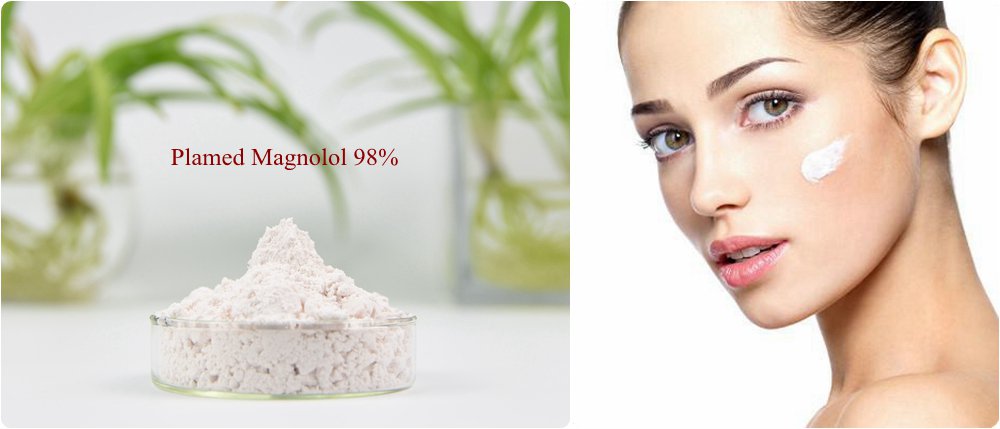
| Product Name | CAS Number | INCI Name | |
| Magnolol | 528-43-8 | MAGNOLOL | |
| Molecular Formula | Molecular Weight | Molecular Structure | |
| C18H18O2 | 266.32g/mol | 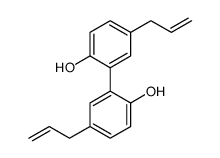 |
|
| Product ID | Specificcation | Minimal Package | Minimal Order Quantity |
| PMQD0202 | 98% | 1KG | 1KG |
2. Magnolol Source
Magnolia officinalis (Latin name: Magnolia officinalis Rehd. Et Wils.) is a deciduous plant of genus Magnolia of Magnoliaceae. The content of Magnolol in magnolia’s different parts varies greatly; the total content of Magnolol in magnolia leaves is 2.30%, while the total content in root of magnolia is 8.22%. However, magnolia grows slowly and has a long growth cycle. It generally takes 10 to 15 years. In addition, magnolia is now listed as a national secondary wild protection plant. Therefore, extracting Magnolol from plant magnolia has a considerable destruction to natural resources. Nowadays, synthesis method is efficient and can protect magnolia resources.

| Plant extraction | Chemical synthesis | |
| History | In 1930s, a Japanese scholar first isolated Magnolol from magnolia officinalis. | It is first synthesized by Swedish scientists H.Erdtman and J.Runebeng through the coupling reaction using 4-allylphenol as raw material. |
| Advantage | Natural source; high purity. | The reaction treatment is simple and efficient; low cost; magnolia resources protection. |
| Disadvantage | Serious damage to natural resources. | Too much residual organic solvents; discharge of chemical waste liquid; serious chemical pollution. |
| Improved method | Magnolia leaf also contains Magnolol, but the content is low, only 0.29-0.36%. However, magnolia leaves are abundant, and the fallen leaves are of equal quality with magnolia bark every autumn. Therefore, extracting Magnolol from leaves not only protects magnolia resources, but also is economical. | Endogenous fungi fermentation to produce Magnolol. |
3. Magnolol Manufacturer Specifications
| Product Name | Specification |
| Magnolol | 98% HPLC |
| Items | Specification | |
| Assay | ≥98.00% | |
| Color | White fine powder | |
| Odor | Characteristic | |
| Taste | Characteristic | |
| Extract Solvent | Water & ethanol | |
| Part used | Bark | |
| Physical Characteristics | ||
| Particle Size | 98% through 80 mesh | |
| Moisture | ≤1.00% | |
| Ash content | ≤1.00% | |
| Bulk density | 50-60g/100ml | |
| Solvent Residue | Eur. Pharm | |
| Heavy Metals | ||
| Heavy metals | ≤10ppm | |
| Arsenic | ≤2ppm | |
| Plumbum | ≤2ppm | |
| Microbiological Tests | ||
| Total Plate count | ≤1000cfu/g | |
| Yeast & mold | ≤100cfu/g | |
| Escherichia coli | Negative | |
| Staphylococcus | Negative | |
| Salmonella | Negative | |
Magnolol Chromatogram
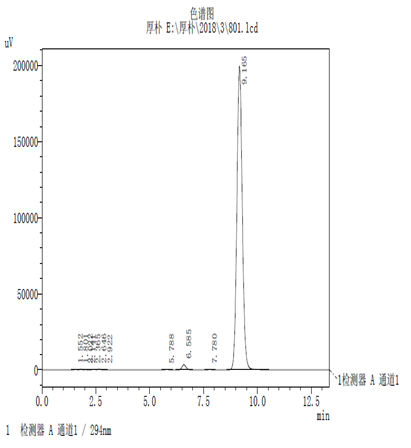
4. Magnolol Manufacturer Flow Chart
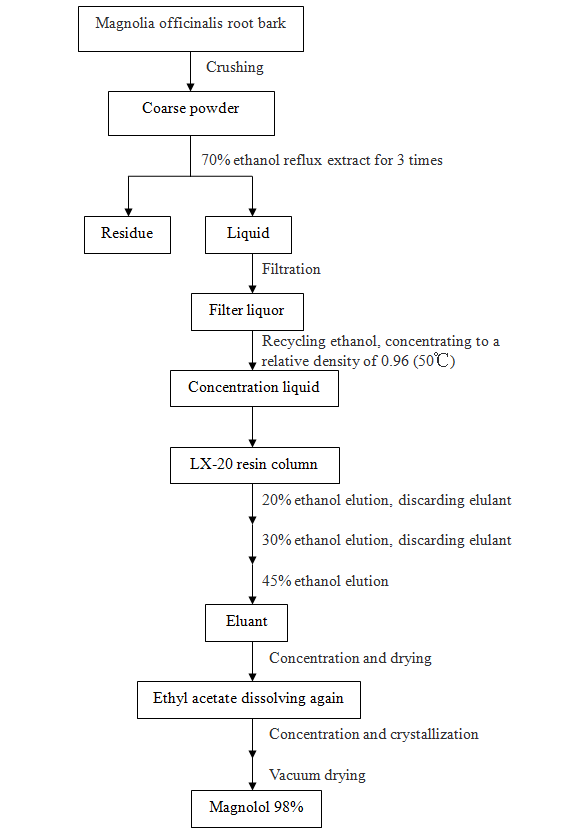
5. Magnolol Benefits
- Acne treatment and anti-inflammation
Inhibition test result of propionibacterium acnes shows that Magnolol has a stronger inhibitory effect on propionibacterium acnes than metronidazole. Magnolol can inhibit production of inflammatory enzymes, and suppress activation of NF-κB and MAPKs. It exhibits anti-inflammation property. Studies have found that Magnolol can significantly affect function of leukocyte; and it has a strong inhibitory effect on the biosynthesis of inflammatory mediators LTB4 and 5-HETE. Because of its anti-inflammatory activity, Magnolol can be used in acne treatment products to prevent skin inflammation.
- Anti-bacterial
Study indicates that Magnolol can significantly inhibit the growth and production of cariogenic bacteria including streptococcus mutans, streptococcus sanguis, lactobacillus; and its inhibition effect strengthens with the increase of concentration. So Magnolol can be used for periodontitis treatment in oral care products. In addition, Magnolol can also be used as a natural antiseptic in cosmetic cream. A domestic experiment is conducted to add Magnolol as a preservative to facial cream; and appearance, aroma and pH of the cream are normal, which indicates that Magnolol has good compatibility.
- Whitening
It has been proved by some scholars that inhibitory rate of 0.01% Magnolol on tyrosinase is 64.2%. Magnolol is a whitening agent that can capture free radicals and inhibit tyrosinase activity. Using L-tyrosine or L-dopa as substrate and kolic acid as positive control, it is found that Magnolol has good effect of inhibiting tyrosinase. It proves that Magnolol has certain whitening effect and can be added into cosmetics as skin whitening agent.

6. Pharmacological studies of Magnolol and cosmetics
| Test Item | Concentration | Result |
| Elimination of hydroxyl radicals | 0.2mmol/L | Elimination rate: 81.2% |
| Inhibition of unsaturated fatty acid peroxidation | 0.2mmol/L | Elimination rate: 87.8% |
| Inhibition of tyrosinase activity | 0.01% | Inhibition rate: 64.2% |
| Activation of peroxidase PPAR | 100μmol/L | Promotion rate: 206(blank 100) |
| Inhibition of NF-kB cell activity | 20μmol/L | Inhibition rate: 61.3% |
| Inhibition of IL-1 production induced by LPS | 3.123mg/mL | Inhibition rate: 54.9% |
| Inhibition of IL-6 production induced by LPS | 3.123mg/mL | Inhibition rate: 56.3% |
7. Plamed Magnolol Characteristic
- Plamed possesses mangnolia officinalis planting base, so we can guarantee a stable supply.
- Plamed Magnolol’ solvent residue is lower compared to other factories. And it is less irritation to skin.
8. Magnolol Application
- Magnolol, due to its anti-bacterial property, can be used as cosmetics preservative, and can be added into toothpaste and mouth wash for treatment of periodontitis (the recommended dosage in dental product is 0.4%).
- Magnolol, because of its anti-inflammatory activity, can be applied in cream, emulsion, essence and mask to prevent pimple, acne.
- As a skin-whitening agent, Magnolol also can used in whitening mask, cream and cleanser.
Magnolol application cases in major cosmetic brands in the world:
| Country | Brand | Product |
| China | MULANTE | Peptide Luxury Protection Cream |
| Skin Designer | Hydrating Silk Mask | |
| DR.WU | Pore Clarifying Toner with BHA | |
| EEASSU | Active Peptide Enriched Toner | |
| Switzerland | L’ADMIRER | (Beauty Plus Defensil Concentrate |
| USA | NARS | Soft Matte |
| ORIGINS | Refreshing Eye Cream | |
| France | MedSPA | MedSPA Botox-Like Swiss Syn-Ake Lifting Serum |
| Isabelle Lancray | Isabelle Lancray Gommage Visage Doux-Gel Exfoliant Moussant | |
| Korea | ASF | ASF ANTI-SEBUM After Skin AC Lotion |
| German | Eucerin | Volume-Filler Day Care Dry Skin |
| Japan | IMPRESS | White Cream Returnergy
White Returnergy A |
| KANEBO | Blanchir Superior Whitening W Conclusion E |

9. Magnolol Reference Formula
Bath soap
| Ingredient | Content(%) | Ingredient | Content(%) |
| Magnolol | 0.8 | Lauric acid | 2.5 |
| KOH | 3.6 | Myristic acid | 7.5 |
| Fragrance | 0.6 | Pigment | 0.001 |
| Oleic acid | 2.5 | Lauryl diethanolamide | 5 |
| Glycerin | 20 | Palmitic acid | 2.5 |
| Aqua | Add to 100 | ||
Lotion for external use
| Ingredient | Content(%) | Ingredient | Content(%) |
| Magnolol | 1.0 | Ethanol | 10.0 |
| 1,3-Butanediol | 4.0 | Water | Add to 100 |
Whitening toner
| Ingredient | Content(%) | Ingredient | Content(%) |
| Magnolol | 1.0 | Ethanol | 10.0 |
| 1,3-Butanediol | 10.0 | Water | Add to 100 |
10. Magnolol Safety
- Cosmetic, Toiletry &Fragrance Association (CTFA) has specified Magnolol as a cosmetics ingredient.
- Magnolol is listed on The International Catalogue of Chinese Cosmetic Raw Materials Standards in 2010 issued by CAFFCI and On the Announcement of Name List of Cosmetics Raw Material published by CFDA in 2014. No reports show its insecurity.
11. Packing and Storage
Package: Packed in 25kg paper drums with two plastic bags inside.
Storage: Stored in a cool dry place and away from direct sunlight and oxidizing agents.
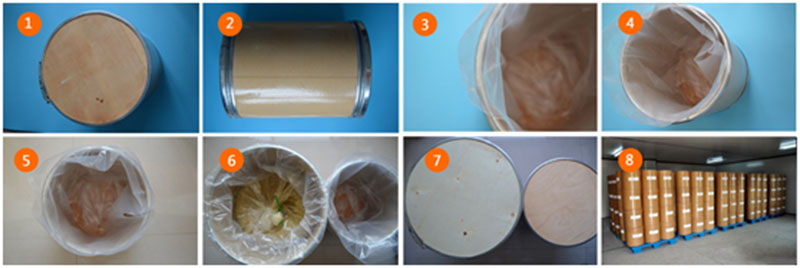
12. Related Reading
2. Magnolia Officinalis Bark Extract Introduction
Plamed focuses on natural cosmetic ingredients for more than 10 years. We have founded four subsidiary companies, which respectively develops different kinds of cosmetic raw material. Plamed is a company whose CEO is designated as the first secretary general of Shaanxi Plant Extraction Association.
As a professional Magnolol manufacturer, Plamed have been constantly upgrading the production process. We firmly believe that good Magnolol and good Magnolol price will help customers make good terminal products and help customers win a lasting and broad market.













